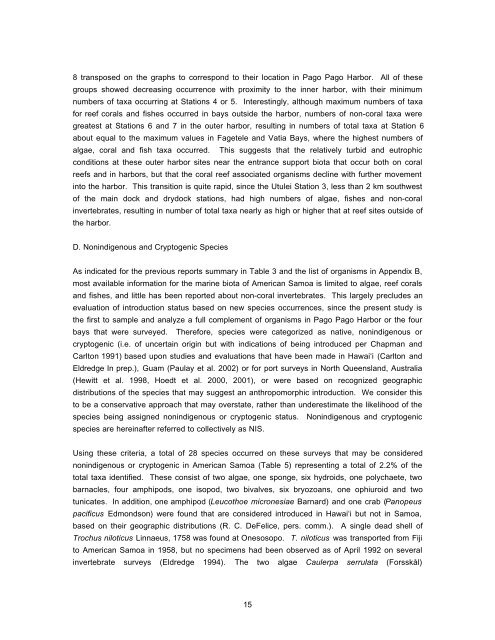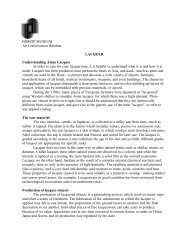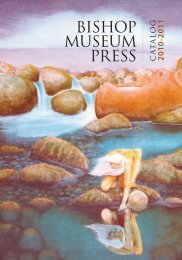INTRODUCED MARINE SPECIES IN PAGO ... - Bishop Museum
INTRODUCED MARINE SPECIES IN PAGO ... - Bishop Museum
INTRODUCED MARINE SPECIES IN PAGO ... - Bishop Museum
You also want an ePaper? Increase the reach of your titles
YUMPU automatically turns print PDFs into web optimized ePapers that Google loves.
8 transposed on the graphs to correspond to their location in Pago Pago Harbor. All of these<br />
groups showed decreasing occurrence with proximity to the inner harbor, with their minimum<br />
numbers of taxa occurring at Stations 4 or 5. Interestingly, although maximum numbers of taxa<br />
for reef corals and fishes occurred in bays outside the harbor, numbers of non-coral taxa were<br />
greatest at Stations 6 and 7 in the outer harbor, resulting in numbers of total taxa at Station 6<br />
about equal to the maximum values in Fagetele and Vatia Bays, where the highest numbers of<br />
algae, coral and fish taxa occurred. This suggests that the relatively turbid and eutrophic<br />
conditions at these outer harbor sites near the entrance support biota that occur both on coral<br />
reefs and in harbors, but that the coral reef associated organisms decline with further movement<br />
into the harbor. This transition is quite rapid, since the Utulei Station 3, less than 2 km southwest<br />
of the main dock and drydock stations, had high numbers of algae, fishes and non-coral<br />
invertebrates, resulting in number of total taxa nearly as high or higher that at reef sites outside of<br />
the harbor.<br />
D. Nonindigenous and Cryptogenic Species<br />
As indicated for the previous reports summary in Table 3 and the list of organisms in Appendix B,<br />
most available information for the marine biota of American Samoa is limited to algae, reef corals<br />
and fishes, and little has been reported about non-coral invertebrates. This largely precludes an<br />
evaluation of introduction status based on new species occurrences, since the present study is<br />
the first to sample and analyze a full complement of organisms in Pago Pago Harbor or the four<br />
bays that were surveyed. Therefore, species were categorized as native, nonindigenous or<br />
cryptogenic (i.e. of uncertain origin but with indications of being introduced per Chapman and<br />
Carlton 1991) based upon studies and evaluations that have been made in Hawai‘i (Carlton and<br />
Eldredge In prep.), Guam (Paulay et al. 2002) or for port surveys in North Queensland, Australia<br />
(Hewitt et al. 1998, Hoedt et al. 2000, 2001), or were based on recognized geographic<br />
distributions of the species that may suggest an anthropomorphic introduction. We consider this<br />
to be a conservative approach that may overstate, rather than underestimate the likelihood of the<br />
species being assigned nonindigenous or cryptogenic status. Nonindigenous and cryptogenic<br />
species are hereinafter referred to collectively as NIS.<br />
Using these criteria, a total of 28 species occurred on these surveys that may be considered<br />
nonindigenous or cryptogenic in American Samoa (Table 5) representing a total of 2.2% of the<br />
total taxa identified. These consist of two algae, one sponge, six hydroids, one polychaete, two<br />
barnacles, four amphipods, one isopod, two bivalves, six bryozoans, one ophiuroid and two<br />
tunicates. In addition, one amphipod (Leucothoe micronesiae Barnard) and one crab (Panopeus<br />
pacificus Edmondson) were found that are considered introduced in Hawai‘i but not in Samoa,<br />
based on their geographic distributions (R. C. DeFelice, pers. comm.). A single dead shell of<br />
Trochus niloticus Linnaeus, 1758 was found at Onesosopo. T. niloticus was transported from Fiji<br />
to American Samoa in 1958, but no specimens had been observed as of April 1992 on several<br />
invertebrate surveys (Eldredge 1994). The two algae Caulerpa serrulata (Forsskål)<br />
15






